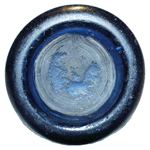jwpevahouse
Well-Known Member
- Joined
- Oct 16, 2021
- Messages
- 136
- Reaction score
- 166
- Points
- 43
Early US bottle collectors developed their own terminology and theories about Victorian bottle making techniques. After 50 years they haven't changed much and were mostly guesses. The "punky" mark became the pontil, a word not found in any English dictionary. It was definitely created when the iron punty rod was attached to the base of bottle with a glob of molten glass. Anything beyond that is pure speculation as to what made the surface of the mark left when the rod was removed. My theory, just a theory, is all "pontil" marks before 1860-70 started as rough broken glass adhering to the bottom subsequently removed by grinding and polishing to produce what we now see and call "an iron pontil", mostly just some residue form a stone grinding wheel which contained iron oxide. The punty rod method is still used in producing hand made glass but the rough glass residue is either left of polished off.When was this introduced into the manufacturing process?




